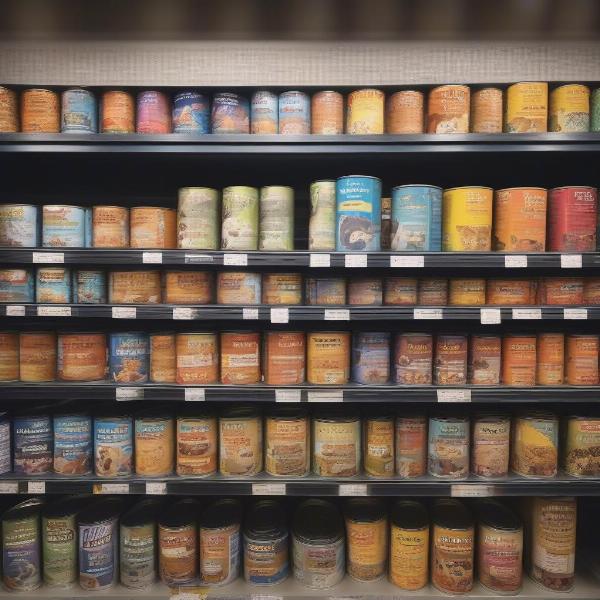Dog food tins offer a convenient and often palatable way to feed your canine companion. But with so many brands, flavors, and formulations available, choosing the right dog food tin for your furry friend can feel overwhelming. Understanding the key factors to consider, from ingredients and nutritional value to life stage and dietary needs, is crucial for ensuring your dog receives the best possible nutrition. This guide will explore everything you need to know about selecting the perfect dog food tin.
 Choosing the Right Dog Food Tin for Your Dog
Choosing the Right Dog Food Tin for Your Dog
Decoding Dog Food Tin Labels: Ingredients and Nutritional Value
One of the first steps in choosing the right dog food tin is understanding the label. Look for a complete and balanced diet formulated for your dog’s life stage (puppy, adult, senior). The ingredient list is listed in descending order by weight, meaning the first ingredient is the most prevalent. Look for high-quality protein sources like meat, poultry, or fish as the primary ingredients. Avoid fillers like corn, wheat, and soy, which offer little nutritional value.
What are the Essential Nutrients?
Dogs require a specific balance of proteins, fats, carbohydrates, vitamins, and minerals for optimal health. Look for dog food tins that provide adequate levels of these essential nutrients. The guaranteed analysis on the label will list the minimum percentages of crude protein, crude fat, crude fiber, and moisture.
Life Stage and Breed Considerations
A puppy’s nutritional needs differ significantly from those of an adult or senior dog. Puppies require higher levels of protein and fat to support their rapid growth and development. Senior dogs, on the other hand, may benefit from lower calorie diets with added joint support supplements. Breed-specific formulas are also available, catering to the unique nutritional requirements of certain breeds. dog food tins come in various formulations to cater to these needs.
Addressing Specific Dietary Needs
If your dog has allergies or sensitivities, choosing a hypoallergenic or limited ingredient diet is crucial. These formulas contain a restricted number of ingredients to minimize the risk of allergic reactions. For dogs with digestive issues, look for dog food tins with added probiotics and prebiotics to support gut health. You can find specialized options like instinct be natural dog food that caters to specific dietary requirements.
Budget and Convenience
Dog food tins vary significantly in price, depending on the brand, ingredients, and formulation. While premium brands may offer superior quality and nutrition, there are also affordable options that provide adequate nutrition. Consider your budget and choose a dog food tin that meets your dog’s needs without breaking the bank. butchers dog food tins offer a good balance between quality and price.
How to Transition to a New Dog Food Tin?
When switching to a new dog food tin, it’s essential to do so gradually to avoid digestive upset. Start by mixing a small amount of the new food with your dog’s current food, gradually increasing the proportion of new food over several days. This allows your dog’s digestive system to adjust to the change. For smaller dogs, you may want to explore options like tiny dog food. Also, consider checking out winalot dog food tins as another option.
Conclusion
Choosing the right dog food tin is an important decision that can significantly impact your dog’s health and well-being. By carefully considering your dog’s individual needs and understanding the information on the label, you can ensure your furry friend receives the optimal nutrition they need to thrive.
FAQ
- How much dog food should I feed my dog? The recommended feeding amount varies depending on your dog’s age, breed, size, and activity level. Consult the feeding guidelines on the dog food tin or speak with your veterinarian for personalized recommendations.
- What are the signs of a food allergy in dogs? Common signs of food allergies include itchy skin, digestive upset, ear infections, and hair loss.
- Can I mix wet and dry dog food? Yes, you can mix wet and dry dog food. This can be a good way to add variety and moisture to your dog’s diet.
- How long can I store an opened dog food tin? Once opened, store dog food tins in the refrigerator and use within 3-5 days.
- Are grain-free dog food tins better for my dog? Not necessarily. While some dogs may benefit from a grain-free diet, it’s not essential for all dogs. Consult with your veterinarian to determine if a grain-free diet is appropriate for your dog.
- What should I do if my dog refuses to eat their new dog food? Try mixing the new food with their current food, warming it up slightly, or adding a small amount of low-sodium broth. If your dog continues to refuse to eat, consult with your veterinarian.
- How can I tell if a dog food tin is high quality? Look for high-quality protein sources listed as the primary ingredients, avoid fillers like corn, wheat, and soy, and choose a complete and balanced diet formulated for your dog’s life stage.
About ILM Dog:
ILM Dog is your trusted international resource for all things dog-related. We offer expert advice on everything from choosing the right breed and understanding dog health and nutrition to training tips and product recommendations. Whether you’re a seasoned dog owner or just starting your journey with a new puppy, we have the resources to help you provide the best possible care for your canine companion. We are experts in breed selection, health & medical care, training & behavior, nutrition & feeding, and products & accessories. Contact us today to learn more! Email: [email protected], Phone: +44 20-3965-8624.